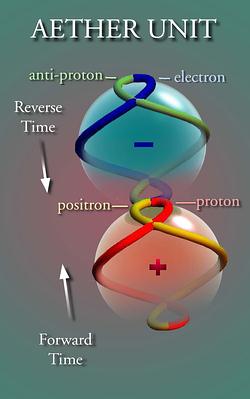Quantum Aether Dynamics: A New Foundation for Physics

This is a paper that was first published in PESWiki but it certainly deserves to be widely known. It is based on a deep re-thinking of current physics and models the aether as a substrate for all things physical.
While the new model is fully developed in a book: Secrets of the Aether that was published in 2004, authored by David W. Thomson III and Jim D. Bourassa, the paper gives a good description of the basic features and lots of detail about how the new model compares with contemporary physics.
Sterling Allan of PESWiki says about it:
"The Aether Physics Model quantifies quantum structure within an Aether/angular momentum paradigm (as opposed to the mass/energy paradigm of Einstein). It is destined to merge with Quantum Mechanics and provides the means for tapping Zero Point Energy."
Abstract
"Modern physics describes the mechanics of the Universe. We have discovered a new foundation for physics, which explains the components of the Universe with precision and depth. We quantify the existence of Aether, subatomic particles, and the force laws. Some aspects of the theory derive from the Standard Model, but much is unique.
A key discovery from this new foundation is a mathematically correct Unified Force Theory. Other fundamental discoveries follow, including the origin of the fine structure constant and subatomic particle g-factors, a slight correction of neutron magnetic moment, a geometrical structure for charge, the quantification of electromagnetic charge as separate from electrostatic charge, a more precise meaning of spin, the quantification of space-resonance in five dimensions, and a new system of quantum units.
The Aether quantifies as a fabric of quantum rotating magnetic fields with electromagnetic, electrostatic, and gravitational dipole structures. Subatomic particles quantify as angular momentum encapsulated in a quantum, rotating magnetic field. All quantum, atomic, and molecular processes can be precisely modeled, leading to discrete physics with new understandings and insights."
- - -
Summary
The Aether Physics Model (APM) is a paradigm of quantum structure, which is based upon
- a clearer definition of dimensions,- a different structure of units based upon distributed charge dimensions,
- a new system of units based on electron values,
- the structure of non-material existence (Aether),
- a new system of geometrical evaluation,
- new fundamental constants in addition to the established fundamental constants,
- the quantification of a previously unknown type of charge,
- and the quantification of matter as angular momentum.
We can postulate that the Universe composes from force, matter, and environment. Space-time is a subset of "environment", which is quantified as Aether. The ontology of the APM assumes quantum matter exists within a quantum environment, and that the quantum environment constructs from primary force acting on quantum dimensional measurements. Let us assume the force as primary, and demonstrate that it factors from Coulomb's constant and Newton's gravitational constant. We name the primary force "Gforce" and assume it is constant, and thus the Universe is a closed system. In this paper, we do not present Gforce as a derived constant from constants that are more fundamental.
The Aether Physics Model (APM) is mathematical and based upon empirical quantum data. Whereas modern physics focuses on what the Universe does, we quantify what the Universe is.
To read the whole paper on PESWiki, follow this link:
A New Foundation for Physics, by Quantum Aether Dynamics Institute





Leslie says about this:
"We are dealing with a 'non-material aether' when we speak of quantum mechanics.
https://sites.google.com/site/aetherwizard/metaphysics-and-physics/map-chapter-2
The construct of the Creation involves both sound (resonance) and light (frequency).
Thus we are speaking of the actual fabric of 'space-time.' This 'fabric" consists of 'potentials'
that permeate throughout the construct, continually 'creating' the systemic nature of the Universe.
P.A.M. Dirac discovered that this 'systemic nature' can be reversed, or 'unhappened.'
A good indication or identifier that this is correct, is demonstrated via the process of the Bedini Monopole System, which demonstrates the reverse of the standard model. Current = heat; Radiant = Cold; The process of desulfation = the unhappening of the chemical process (within the battery).
What Bedini/Bearden have uncovered is the actual potential to re-engineer reality, via the process of precursor engineering. (The reversal of death = immortality).
Leslie R. Pastor"
Quote from the last paragraph (Conclusion) of the PESWiki paper: "... the (APM) model also proposes to answer many more unanswered questions about the nature of the Universe from the quantum level through the cosmic level."
I'd like to have the author explain what levels there are in between 'the quantum through the cosmic level', and likewise what further levels there are beneath and beyond these two levels (presuming he doesn't consider both these being limits).
Here's a plausible answer to my own questioning:
Speaking in terms of levels, my understanding is that the next higher to the quantum level is the solar system level (or generally speaking the stellar level), with the next higher being the galactic level -- which amounts to three levels, whereby both extremes correspond merely to the limits of our observation, i.e. of our microscopes and telescopes.
In my view, there is absolutely no reason why there shouldn't be an infinity of further levels respectively beneath and beyond the author's quantum and cosmic levels, with presumably pretty the same scale ratio as between these three -- which amounts to envisioning a fractal structure of the 'immensity' (i. e. the non-measurable, rather than 'universe' with its connotation of wholeness), from which could be derived the following two axioms expressing the limits of our understanding:
1) Regarding the infinity of levels beneath the quantum level, the first axiom would read: "There is an infinitely high frequency of occurrence of infinitely insignificant events within an infinitely small volume of space".
2) Regarding the infinity of levels beyond the cosmic (i. e. galactic) level, the second axiom would read: "There is an infinitely low frequency of occurrence of infinitely significant events in an infinitely large volume of space ".
It seems only logical to me that these two axioms can't be properly formulated within the scope of human semantics, since the term 'infinity' is definitely beyond our understanding. Nonetheless, it may be useful to specify that by infinitely insignificant events I mean mere particle collisions, whereas by infinitely significant events I mean events of incommensurably higher signification than cognitive events at stellar level (notably at our solar system's level).
A first practical conclusion from the notion of particle collisions would be that attraction forces are nothing but wishful thinking, since all cohesive forces would be deemed to result from particle impacts. This might be illustrated by the example of Earth gravity not attracting but pushing us to the ground through particle collision-generated impulse trains impacting our atomic skeleton -- with those impulse trains coming from the hemisphere below the horizon being more or less obstructed by the Earth's atomic skeleton, leaving a surplus of impact forces from above.
My reply of same day to myself:
A second and more of a philosophic conclusion would be that at an infinitely high order of cosmic levels, a single event would be endlessly in the course of happening OUT there -- whereas at an infinitely low order of quantum levels countless events would happen in no time; whereby, after all, I'm not so sure whether event signification should be related to scale order, which would leave room for imagining civilisations evolving within seconds or minutes on electrons, with maybe English being spoken somewhere IN there...
Now, I can imagine a high-ranking scientist tapping fatherly on my shoulder: "My dear son: we know that infinitely large is really huge, and infinitely small is really tiny -- but, come on: not THAT huge nor THAT small either"...
new concept of VORTEX pratical
http://www.youtube.com/watch?v=LDtsuofgRJ0
Time line is a real number line displaying a list of changes in chronological order in a reference phenomenon, as whose each point corresponds an each change in the reference phenomenon within a closed dynamical system.
Here, the number of zero means that infinitesimally small value, which means that it never reaches an absolute void within our biological framework for consciousness.
And the infinite number means that infinitesimally large value, which means that it never reaches an absolute large matter, within our biological framework for consciousness.
As considering Quantum Field Theory implies that the vacuum is full of virtual particles that emerge and quickly disappear in free space, taking into account the Conservation Law and the Constancy of Speed of Light in vacuum, the free space should be not empty, it might be filled with an invisible perfect fluid with a critical flow speed equal to the light speed.
Consequently, the relative motion in General Theory of Relativity is supposed to be a motion relative to the invisible perfect fluid (called spatial fluid). Therefore, the Speed of Light in vacuum is supposed to be constant relative to its ambient spatial fluid instead of the constancy of the speed of light in all frames of reference.
Creation of all elementary particles including virtual particles are caused by a superluminal relative flow occurred locally.
For neutrino with infinitesimally small mass, its initial speed during its creation must be more than the speed of light and so the neutrino is to be in a superluminal motion, while slightly decelerating.
Spin direction of neutrino must be parallel to its linear momentum in order to reduce the friction in its ambient spatial fluid.